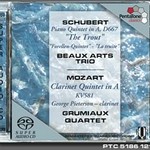
Piano Quintet in A, D667 The Trout / Clarinet Quintet in A KV581
 $40.00
Out of Stock
$40.00
Out of Stock6+ weeks add to cart
SCHUBERT / MOZART
Piano Quintet in A, D667 The Trout / Clarinet Quintet in A KV581
Beaux Arts Trio / Grumiax Quartet
[ Pentatone SACD / SACD ]
Release Date: Friday 18 August 2006
This item is currently out of stock. It may take 6 or more weeks to obtain from when you place your order as this is a specialist product.
Not only are both the quintets by Mozart and Schubert recorded on this CD considered radiant pearls in the oeuvre of two outstanding composers, they also rank first place in a fictive listing of instrumental chamber music.
Hybrid/SACD DSD remastered Playable on all compactdisc players
Not only are both the quintets by Mozart and Schubert recorded on this CD considered radiant pearls in the oeuvre of two outstanding composers, they also rank first place in a fictive listing of instrumental chamber music.
Mozart's Quintet for Clarinet and String Quartet in A, K. 581 dates from September 29, 1789. The clarinettist Anton Stadler - who, as we may gather from contemporary reports, was a virtuoso of the highest ranking - not only encouraged his friend Mozart to write the Clarinet Concerto
K. 622, but also to compose this Quintet. However, despite the considerable virtuosity demanded here, the basic idea behind the work (which lasts about half an hour) is not the emphasizing of purely technical instrumental skill and brilliance, but the portrayal both of a sonorous balance between the five participating instruments and a matching consistency in the treatment of motifs and themes. The clarinet is allowed to dominate insofar as permitted by Mozart's sense of chamber music: it balances on the border-line between solo instrument and partner in the musical structure of the movement.
The first movement (Allegro) is written in sonata form, in which not the clarinet, but the four-voiced, homophonic string part carries the main theme. The clarinet answers in a cliché manner with a cadenza. Not until the development do the strings - which so far had found themselves in thematic isolation - begin to blend with the clarinet, which finally reaches its climax in the recapitulation, when the homophonic main theme is taken up by all five voices. The first segment of the middle movement (Larghetto) is devoted entirely to the lyrical musical idiom of the clarinet, which soars like a voice above the strings, before the first violin and the clarinet begin a dialogue in the middle segment. A short coda rounds off the movement. The Minuet has two trios (first trio for strings only) and again permits the emancipation of the instruments, which had been given free rein for a short period during the Larghetto. Hidden in the Finale (Allegretto) is a variation movement consisting of six variations, in which Mozart once again clearly rejects any show of virtuosity in themes and motifs based simply on outward appearances. The musical activity is divided equally between all five instruments.
The creation of Franz Schubert's Piano Quintet in A, D. 667, dating from 1819, is closely bound to the names of Michael Vogl and Sylvester Paumgartner. The first was a close friend and dedicated promoter of Schubert's music, the last was the actual "initiator" of the composition. In Vogl's home town of Steyr, Paumgartner acted as a kind of patron of music, who staged concerts in his house. As Albert Stadler reported: "He wrote it at the special request of my friend Sylvester Paumgartner, who was highly delighted with the exquisite little song ['The Trout']. According to his wishes, the Quintet was to be composed along the same structural lines and with the same instrumentation as a quintet by Hummel, which was still new at the time [...]." These remarks explain the reference to Schubert's lied "The Trout" and the unusual scoring for piano, violin, viola, cello and double-bass, which is based on J.N. Hummel's Quintet Op. 74.
The first movement (Allegro vivace) does not introduce the main theme directly at the beginning of the work, but gives it 25 measures, in which only the unclear appears to be clear. The theme is broken down into separate pieces, and these inspire a multitude of melodic and rhythmical ideas. The second movement is a lyrical Andante with a multicoloured harmonic form, and this is followed by a Scherzo: Presto, characterized by the turbulence of the rhythm and expression of the motifs. The material of the famous variation movement is derived from Schubert's lied "The Trout" D. 550 set to the poem by C.F.D. Schubart, which itself possesses great variation possibilities. The lied, which portrays a self-contained dramatic scene, is not quoted as such; only the melody of the first verse contains a chamber-musical salute. However, it is remarkable here that Schubert does not present the most easily recognisable part of the lied - the rising sextuplet followed by the two descending quavers in the right hand of the piano - until the sixth and final variation; before that he gets to work on a continuous intensification of variation upon variation.
Tracks:
SCHUBERT:
Piano Quintet in A, D667 "The Trout" "Forellen-Quintet" - "La truite"
MOZART:
Clarinet Quintet in A, KV581

